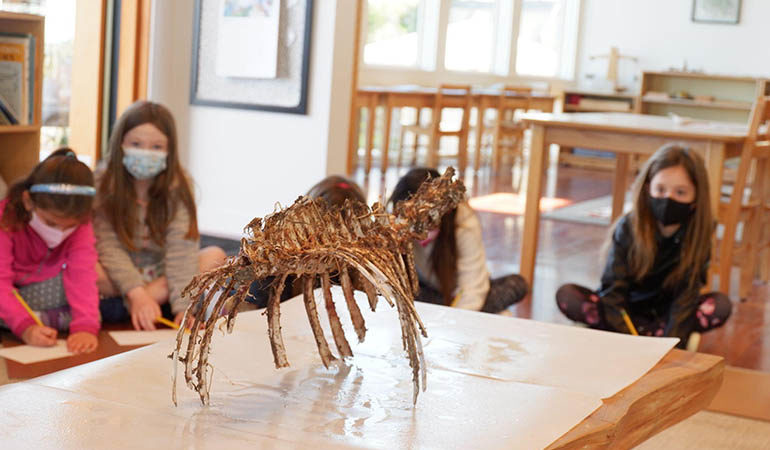Dr. Montessori actually had a lot to say about vultures. As part of her Cosmic Story, she wondered, “And what about the vultures? Faithful to their function of cleaning the earth of things dangerous to other beings, they eat carrion and corpses in putrefaction.”
Among her points: Every creature has its role in the sustaining of life, and sometimes we miss or dismiss their value.
Not so in the Chickadee classroom.
Last spring, a kettle of vultures moved past the huge windows of the Chickadee community. Seeing their large size up close was a surprise and soon, most of the class gathered at the windows including Guide, Jamie Stone.
Sure, other presentations and activities were planned for that day, but when inspiration strikes, Dr. Montessori charges us to follow the child and work with their drive.
The questions piled up furiously:
- What were the vultures doing?
- What do vultures do anyway?
Once the vultures cleared away, Jamie and a group of students headed out to have a look for themselves, and there in the grass they found something remarkable: the remains of an animal whose life cycle has ended. For many students and adults, finding a carcass in the grass would generate many reactions besides curiosity, but for the MMS student, the world and its ways are an endless source of fascination.
More questions arrived:
- What is this?
- Where did it come from?

Jamie prepared a space in the room with an underlay and then headed outside with gloves, disinfectant spray, and the ability to use this moment as a way into the kind of learning and thinking that is at the heart of a Montessori education.
“An experience like this develops the child’s intrinsic motivation,” Jamie said. “Our school is unique because rather than having learning fit into a schedule, we are open to nurture the questions and curiosity of the children.”
The students’ comments became an entry point to discuss everything from anatomy to the differences between observation and speculation. In other words, what do we know to be true versus what do we think is true?
In the end, students had opportunities to learn about the world and themselves. Maybe most importantly, they encountered another moment when the community could come together and ask questions driven by their own curiosity.
And, this is perhaps at the heart of what makes Montessori a unique learning experience. When Maria Montessori was researching Elementary education in preparation for creating the Elementary curriculum, she discovered that there is one thing that is necessary to ensure that children embrace their ability to do hard things.
What is that one thing, you ask? Joy.
When children are motivated by their own curiosity and interest, they learn with joy.


Terry is the Director of Communications and Story at Marin Montessori School. A classroom teacher for 30 years, he manages Grounded and Soaring.





